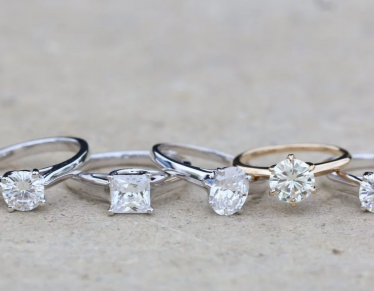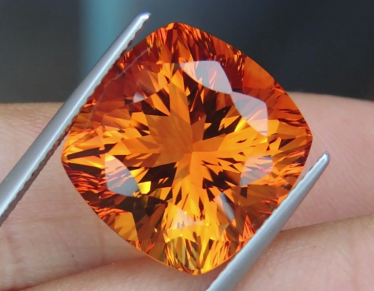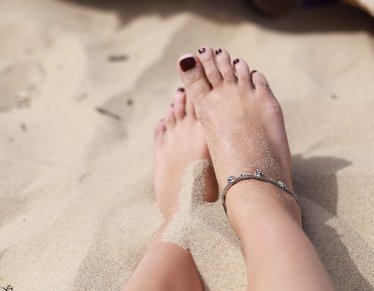Labradorite is not, by any means, a new stone on the market. It’s wildly variant play of color reminds viewers of a coppery sunrise, the dancing skylights of the Aurora Borealis, or Northern Lights, or the dance of sunlight off a deep blue sea. The stone is renowned for its wonderful stripes of prismatic colors and versatility in décor and jewelry.
Discovered in North America in the late eighteenth century, we have known about it for a while. However, it is really coming into its own in the jewelry world in the last few years. It is slowly creeping onto the red carpet on the hands of folks like Julia Robert. As it grows in popularity, it will also be more in demand. Trends in jewelry tend to follow the red carpet and runway pretty closely. However, you can get ahead of the curve! A little know-how, a bit of trend predicting, and you can be leading the charge in the up and coming popular stone.
Before you get started though, here is a handy primer on the out-of-this-world stone. Everything you need to know about labradorite in one handy stop, plus a few of our very favorite labradorite jewelry recommendations as well is all right here on your favorite jewelry blog! Finish reading this article and you will be all ready to do whole jewelry restyling featuring all the beauty and elegance of our new favorite stone.
What is it?
Labradorite is a stunning stone full of color and a lot of really interesting science behind its formation. Itis a member of the feldspar mineral family. Other notable feldspar stones are quartz, moonstone, sunstone, and amazonite.
For some extra sciencey explanation, it is specifically a part of the plagioclase series. In particular, labradorite, in its raw, crystalline form, is most often found in igneous rocks like basalt, gabbro, and norite. Labradorite while is itself an igneous rock can be found in igneous, metamorphic, and sedimentary rocks. Although it is most often found in layers containing heavy amounts of it native rock type, igneous. Labradorite can be the most abundant mineral in anthorosite.

Igneous rock is a type of rock or stone formed by volcanic activity. The intense heat and pressure underground by magma flows compress minerals in various combinations. Diamond is another form of igneous rock, for example. Labradorite is also found in anorthosite, another type of igneous rock in which labradorite can be the most abundant mineral. Anorthosite is a common stone used in architectural applications.
Some versions of labradorite give off something called a schiller effect, otherwise known as adolescence. This is best defined as a milky blue luster, giving off a sort of internal glow. In the case of labradorite, in particular, this presents as a bold look of iridescence. Depending on the angle at which it is viewed, the stone may appear blue, green, red, orange, and yellow colors at any given point. Often the stone has a “base” color, commonly blue, green, brown or orange, although others are found from time to time as well. The rest of the colors appear as flashes, stripes, chatoyancy, veins or striations.
Labradorite is so well known for these spectacular displays of color that now has its own name in both gemology and jewelry: “labradorescence.” Stones with the most beautiful labradorescence are often selected for use in jewelry and other accessories. To really see labradorescence at work check out this ring from MoonMagic.com: Almond Bliss features a wide variety of colors and you can really see those layers of color shine through.

What Causes Labradorescence?
Everyone knows how brilliantly shines a diamond. This glittering effect is created when light strikes the various facets and angles of the surface and reflects all the colors of the spectrum back to the eye. Essentially each little facet cut into a diamond acts like a tiny little prism. Labradorescence works differently. Instead, light enters the stone and strikes a surface within the stone, reflecting back that color to the viewer’s eye. Essentially the stone itself contains all the various colors. It is not just a play of light. Labradorite actually contains the surfaces in all the various colors.
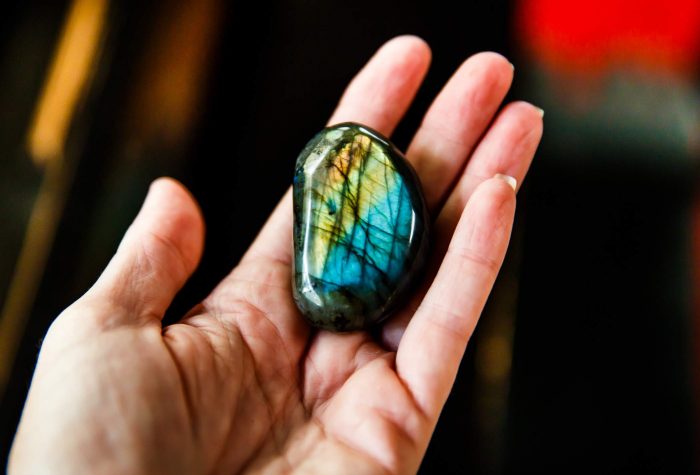
The strips and slashes of colors within the stone is referred to as twinning. Light-reflecting from the various twinning surfaces across the surface of the stone can give the stone a multi-colored appearance. To demonstrate this in jewelry, take a look at this ring, Aurora. The twinning surfaces are vibrantly presented, giving an almost tiger-striped look to the ring. The sizeable stone gives plenty of real estates for the stone to do its work. The setting in 925 Sterling Silver provides a very neutral palette to play on as well.
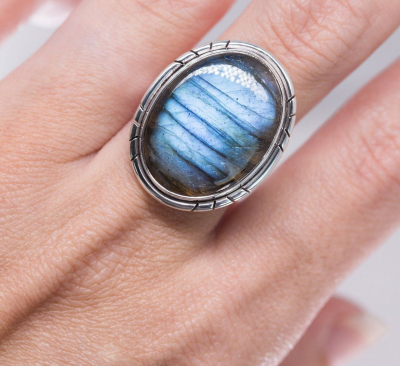
Most examples, although not all, are either opaque, meaning no light passes through the stone itself. In other words, the stone is not clear like a diamond or emerald. A handful of examples are semi-translucent, meaning light can pass through parts of the stone but not all of it. Stones that are semi-translucent often appear as if they are glowing from the inside. These finest examples of labradorite are most popular for jewelry due to their ethereal, other-worldly look.
Properties
Labradorite is a mineral in the plagioclase series, and it shares many of the properties of plagioclase minerals. On the Mohs hardness scale, it scores about 6 to 6 1/2. For comparison, a diamond receives a 10 on the scale whereas talc, an element common in baby powder, is rated at a 1. So it is a medium hardness, slightly prone to scratching but not so much it renders it unwearable.
Labradorite is the only mineral in the plagioclase series that is labradorescent. That said, not all stones are labradorescent. A handful of them is only one color. So, while it is labradorite from a gemological or geological definition, it is simply not as pretty. It is incredibly rare to see these used in jewelry. Without the labradorescence, the stone may be difficult to distinguish from other close cousins from the plagioclase series of stones. There are various methods used by geologists to determine labradorite from other versions of feldspar. These include x-ray diffraction, chemical analysis, optical tests, and specific gravity determinations.
It can also be a part of amalgamation stones like anorthosite as mentioned above. This happens when small bits of various stones are compressed together far beneath the earth’s crust.
Labradorite as a Gemstone
It has become a popular gemstone because of the all that labradorescence we discussed above. The gorgeous rainbow effects make it uniquely qualified as a gemstone for jewelry and other wearable accessories like diadems. The quality, color, and shine of the labradorescence vary from one specimen to another. It may even vary from within the same stone, depending on how big the original core sample was during excavation. Stones with the most exceptional color are often given the name “spectrolite.” Labradorite may feature other names including Oregon sunstone as well.
Luckily for those of us who adore having one of a kind, rare pieces, it is rarely seen in mass-production jewelry applications. You would be hard-pressed to find a piece of labradorite at a big box store or national jewelry store counter name. Instead, it is most often preferred by jewelry designers and creators who deal with custom work like Moon Magic Jewelry. For example, look at this wonderful piece produced by the US-based company. Lynx Light selects labradorite that leans toward the green spectrum and couples it with a burnished 925 Sterling Silver.
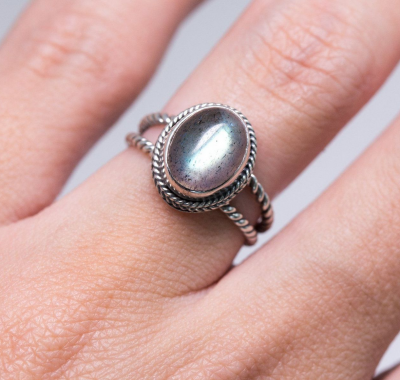
It creates a very vintage feeling ring that is wonderful as an everyday piece. It will complement almost any outfit and is not so obtrusive that it will get in the way of your everyday life. Larger statement rings can sometimes feel a bit bulky for working in, even if you don’t use your hands much in your line of work or selected hobby. This piece really works for it though.
Many specimens do not exhibit labradorescence. It is rare that these are included in jewelry due to their monotone tendencies however, they can still produce beautiful gemstones because of their absolutely gorgeous coloring and other optical effects such as aventurescence. Aventurescence is similar to labradorescnece but instead of reflecting rainbows or containing a sort of inner glow, aventurescent stones look like they are full of tiny specks of glitter.
Jewelers and artisans must be incredibly careful when using labradorite as a gemstone. Due to a unique characteristic, it breaks in two directions under most circumstances. This is a part of a geological concept known as cleavage. With the appropriate conditions, cleavage is how the cracks form through the stone when pressure is applied. Due to the makeup of labradorite, the stone makes two distinct cracks thus breaks into three pieces. These pieces probably will not be perfectly even.
This is part of the reason why it is pretty rare to find a sizeable piece of labradorite. It is subject to breaking when impacted. Too large a stone and you risk your wearer losing their new favorite piece to a devastating shattered stone. But never, fear. The beauty of the stone is such that even dainty pieces get really make an impact. Just take a look at Yonder Glow from one of our favorite jewelry creators, Moon Magic Jewelry. The stone is not large but paired with the 14k rose gold, it still has plenty to say. And the beautiful play of color speaks the loudest.
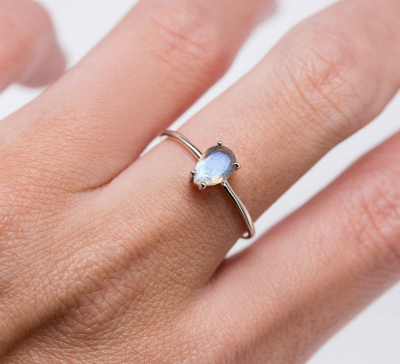
Working with Labradorite in Jewelry
Labradorescent material is most often cut into cabochons. Cabochons are smooth cut and polished gems. Many fine gems are cut with facets, or faces and angles, to make the most out of the play of light.
However, since labradorite does not need the faces and angles to look beautiful and, as mentioned above, can be a little tricky to cut due to the cleavage issue, cabochons are very popular in the jewelry world.
Each facet cut increases the chance that a break may occur. Thus smooth, polished cabochons are most often seen in jewelry applications. Cabochons are perfect for stones with chatoyancy (the cat-eye effect) and labradorescence.
However, a cabochon is not the only wonderful way to feature the stone. It is a little more versatile than that.
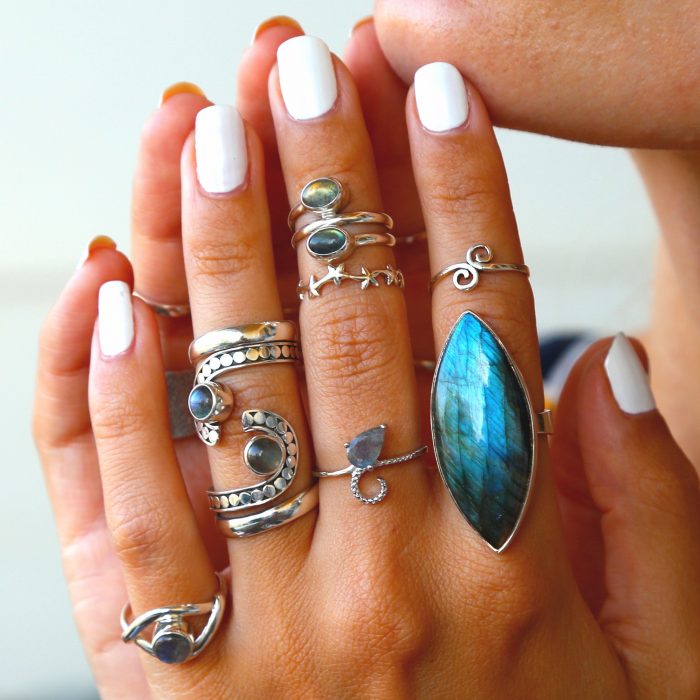
It can also be carved by the most talented artisans. It shares some properties with jade. Since it is solid stone with few to no clear spaces, the detail of the carving is not lost. The hardness of the gem also lends itself to carving as well. It is not so hard that diamond-tipped tools are required for the details but not so soft that any sort of detailing creates chips or uneven lines. There are examples of carved labradorite with floral motifs, leaves, animal faces, and geometric designs.
Labradorite as a gemstone is considered most beautiful when the cabochon is cut carefully. The layers of the stone and the surfaces of color must be considered when selecting how to position the stone. Because it is naturally a crystalline shape, those twinning layers may be stacked crossway across each other. The artist and gemologist must thoughtfully consider each stone so that the finished product will be positioned to produce a full “face-up color.”
If the stone is cut at the incorrect angle, the twinning layers that produce all those amazing colors will be tilted when the stone is viewed from directly above or directly in front. What this creates is a stone that looks off-center even though by the math it is perfectly cut.
Labradorite Around the World
It is named after the place in which it was first discovered. It was first found on the Isle of Paul, near Nain, Labrador, Canada. The brilliant, mind-bending gem was discovered there in 1770 by a Moravian missionary.
It has since been found in Finland. In fact, the very best examples of the stone have been found in the Baltic nation. The highest quality examples of labradorite were granted the moniker “spectrolite” by the director of the Geological Survey of Finland. Since that designation was bestowed, several other deposits of spectrolite level labradorite have been discovered across varying locations around the globe.
A significant amount of it that features a gray to the black base color and with good labradorescence has been uncovered locations in both Madagascar and Russia. Tiny amounts of semi-transparent labradorite with color flash deep in the interior of the crystals have been unearthed in India. However, these are incredibly rare and slightly softer. Very few of them are hearty enough to tolerate a jewelry application.
Semi-transparent orange, yellow, red, blue, green, and clear labradorite without labradorescence have been located in Oregonian mines in the Northwestern United States. These clearer stones are great for the adventurous jeweler willing to experiment with carving and faceting. This version of labradorite is reminiscent of diamond and cubic zirconia when cutting a specific way.
Occasionally some of the beautiful pieces of this Oregan version feature inclusions of copper that can produce an aventurescent effect when catching the light. These most unique specimens are typically called the Oregon Sunstone we referenced above. However, the name is sometimes applied liberally to the Indian version and others with an orange, yellow, or coppery tendency.
Styling Labradorite in Fashion & Jewelry
It is incredibly versatile when it comes to styling. Depending on the base color it can go with just about any color of wardrobe. It is also wonderful for both evening and daytime looks. Even the most casual outfit can benefit from a great pop labradorite jewelry
If you are looking specifically for a perfect piece for evening wear, labradorite is a great go-to for the hands. Since it represents so many beautiful colors in just one stone, you can wear your choice of stones in necklace, earring, and bracelet and match a lovely labradorite ring with it.
The prismatic effect of the labradorescence will make them all work wonderfully. Just look at this piece with all the bling you need: Moon Child.
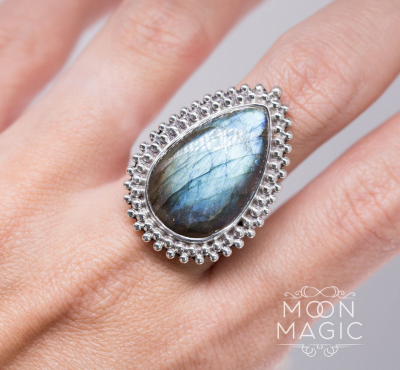
This statement ring is positively stunning, the almond shape of the stone pointing upward toward the knuckle. The beautiful striations and splashes of color will pick up the cooler tones from your outfit and compliment even warmer stones like peridot and emerald. Plus, it mixes up your stone choices a little bit, adding some variation to your accessory game. The ring of crystals around the edge kind of pushes it to the next level.
Labradorite in Crystal Healing
Labradorite is often referred to as a protective and grounding crystal. It is tied to the earth as the base of the stone is often in grey or black, even if it does not look that way due to the rainbow effect of labradorites natural twinning surfaces. However, much of labradorite magical properties are tied to astral influences in the heavens.
It can assist in keeping its user or bearer grounded and centered on the Earth, maintaining a solid basis of understanding. While doing this the high reflectivity of the prismatic surface helps to explore higher energies. The labradorescent display of colors can help channel energies coming from many different directions and help choose the best path.
Because it is an earth stone as well as an astral stone it is a wonderful guide stone. It keeps the bearer in touch with the earth, grounded and centered while also illuminating the way. It can help makes decisions both physically and emotionally through the base of grey and rainbow of play of light.
If you are wanting to include a daily wear piece of labradorite to make the most out of its guiding principles, take a look at this find on MoonMagic.com.
Ornamented Teardrop combines all the guiding power of the stone into an almost Evil Eye look. We think the grounding effects of the labradorite when presented inside a powerful talisman like the evil eye to ward off ill-fates, and you ought to be set up on a pretty firm foundation.
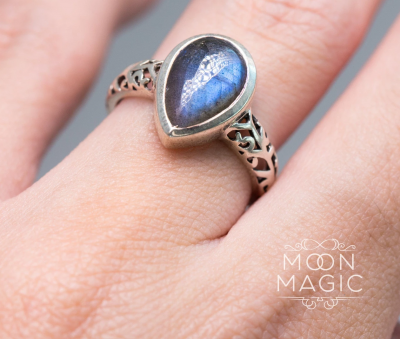
It does have a tendency to increase the occurrence of coincidence. Again, because of the duality of the crystal, it is easy for energies to converge around it. Things that might not have otherwise occurred at the same time are made slightly more likely while working with labradorite. It is almost as if the stone ethereally channels desires of those around them and making improbable moments come together.
On that same token, it can also increase synchronicity. Coming to the same conclusion or quickly finding a middle ground during a discussion or debate is synonymous with the power of labradorite. This makes it great to keep around during a business meeting or potentially difficult discussions with a loved one. If you can avoid an argument because those energies are being channeled through the stone, why not give it a shot, right?
To help harness that type of filtering energy try picking up the Sneaky Light. The coupling of the labradorite with the smooth glow of the 925 Sterling Silver moon will help really harness the tempering elements. It encourages you to travel but helps keep you focused.
Just as the light of the moon provides just enough light to see your path but not much more, the labradorite will help guide and ground your next new endeavor. We adore when the symbols and the stones line up. We feel like that only increases the power of the stone!
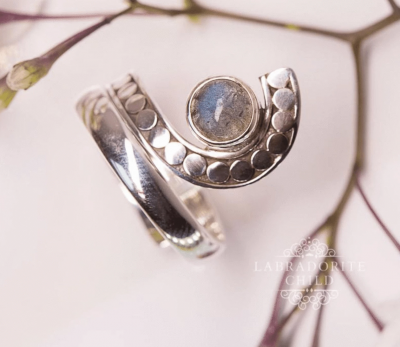
All in all, we are so excited that labradorite is the next up and coming star of the jewelry scene. It is uniquely beautiful and economical at that. Unlike the more well-known gems like diamond and sapphire, labradorite gives you all the stunning beauty of those with a bit more flare for the intriguing. It is also far more reasonably priced than the others. And if you can save a bit of money, piece for piece, you can buy even more!
The gem is wonderful in adding a pop of a lot of color in a small space. It is almost like a superpower in our opinion. To prove this, take this Iconic Delta ring as an example. The blue stone matches up with 14k rose gold vermeil so wonderfully. The warm, rosy gold plate really highlights the warmer tones in the labradoresence of the gem. We love the choice of the triangle as well!
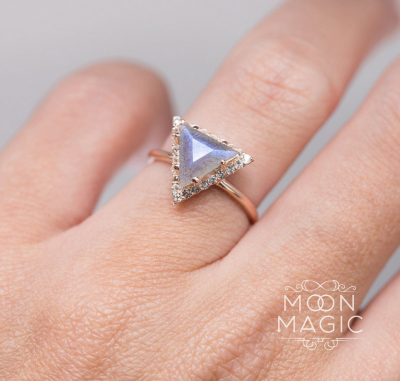
Whether you choose to incorporate it into your daily looks or give it a special place of honor in your most elegant looks, the stone works with you instead of trying to steal the show. Our first choice in some of the finest rings, earrings, and pendants featuring labradorite is Moon Magic Jewelry. They have proven themselves in both quality and selection! We are huge fans of theirs and we are confident you will be too!

